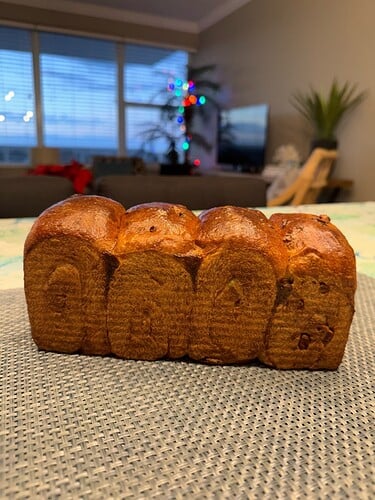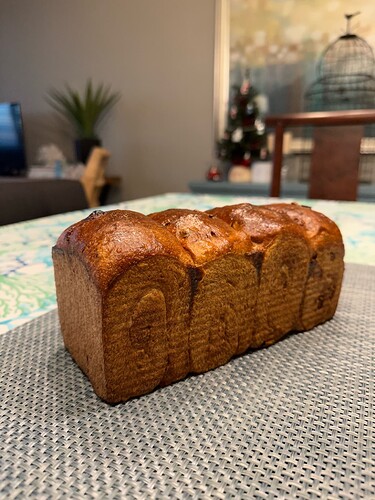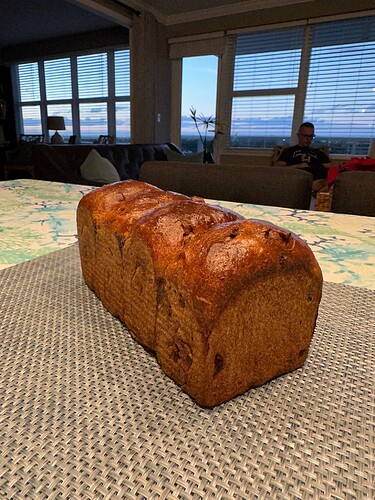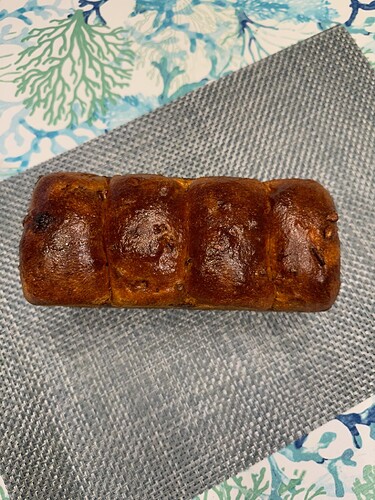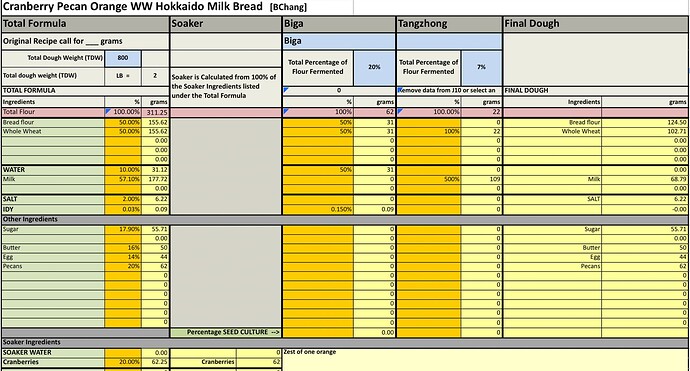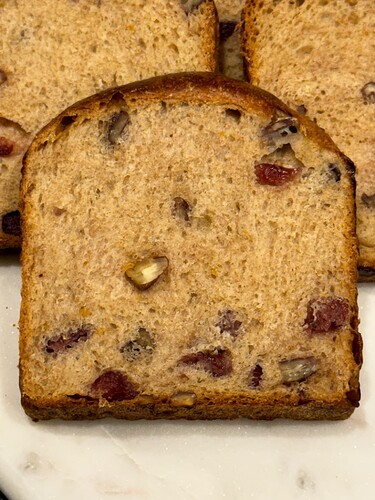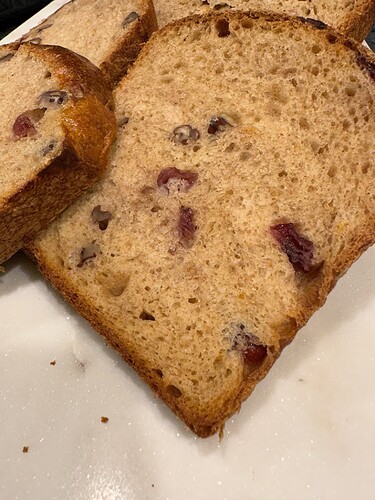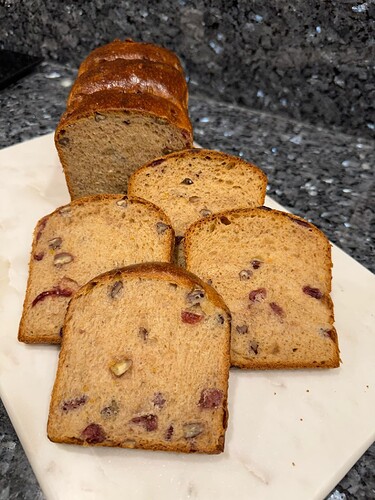I did not bring my starter with me to Florida. Instead, I have decided that I would bake using preferments using tiny amounts of IDY. Today I baked a loaf using a biga. The main reason I chose a biga is that I want milk to be the main hydrating liquid for this bread rather than water, it is a milk bread after all. I didn’t do a good job accounting for the humidity of Fort Lauderdale and the formula I wrote up ended up with a dough that was too wet. I gradually added little bits of flour until it wasn’t so wet. That isn’t ideal of course but next time I’ll start with milk at 5-10% less and bassinage more in if I need to. I also do not have a mixer down here in Fort Lauderdale so did this enriched dough all by hand. I probably didn’t develop the gluten quite enough, although in the end it looks fine.
For this loaf I wanted to incorporate some holiday flavours since we’ve decorated our apartment for Christmas already and felt in the mood. I love cranberry and orange together and since we’re in the south, pecans of course.
This was my first time working with King Arthur Whole Wheat flour, it is quite different from the organic stoneground whole wheat I am used to which has much larger bran particles. This also affected the hydration of the dough and is yet another thing I’ll have to adjust for the next bake.
For a 9x4x4” Pullman pan
The night before, prepare tangzhong and biga.
Soak cranberries with just enough water to cover
Tangzhong
In a sauce pan set on med heat with about 1.5 cm of water, place the bowl of your stand mixer creating a Bain Marie, whisk the milk and flour until blended. Then cook for several minutes until thickened, stirring regularly with a spoon or heat-resistant spatula. Let cool.
In a small container, mix the flours for the biga. In a separate container dissolve the IDY in the water. Pour the IDY water into the container with the flours. Mix well to fully hydrate the biga. Allow to ferment overnight at room temperature. In the morning it should be domed and ready to use.
Dough
In the bowl of a stand mixer, add the milk (consider holding back 5 g of milk and adding later if this is the first time you’re making this), egg, tangzhong, salt, sugar, diastatic malt and biga. Mix and then break up the biga into many smaller pieces. Next add the flour. I like to use my spatula to mix until there aren’t many dry areas. Allow the flour to hydrate (fermentolyse) for 20-30 minutes. Mix on low speed and then medium speed until moderate gluten development this may take 5-10 mins. You may want to scrape the sides of the bowl during the first 5 minutes of mixing. Next add room temperature butter one pat at a time. The dough may come apart, be patient, continue to mix until it comes together before drizzling or adding in more butter. Once all the butter has been added and incorporated increase the speed gradually to medium. Mix at medium speed until the gluten is well developed, approximately 10 mins. You will want to check gluten development by windowpane during this time and stop mixing when you get a good windowpane. You should be able to pull a good windowpane, not quite as good as a white flour because the bran will interrupt the windowpane somewhat. Add the strained cranberries and pecans, mix until they are well incorporated in the dough.
On the counter, shape the dough into a tight ball, cover in the bowl and ferment for 2-2.5 hours at 82ºF. There should be some rise visible at this stage.
You can next place the dough into the fridge to chill the dough for about 1.5 hours, this makes rolling the dough easier to shape. Remember, if you do so the final proof will take longer. Alternatively, you can do a cold retard in the fridge overnight, however, you may find that this increases the tang in your bread.
Prepare your pans by greasing them or line with parchment paper. A tip if you’re using very soft butter to grease your pan, after greasing the pan, place it in the fridge for a bit to firm up the butter that way the butter won’t just melt into the dough.
For baking as rolls
Lightly flour the top of the dough. Scrape the dough out onto a clean counter top and divide it into 12. Shape each tightly into boules, allow to rest 5 mins. Using a rolling pin roll each ball out and then shape tightly into boules. Place them into your prepared pan.
For baking as a loaf
Prepare your pans by greasing them with butter or line with parchment paper.
Lightly flour the top of the dough. Scrape the dough out onto a clean counter top and divide it into four. I like to weigh them to have equal sized lobes. Shape each tightly into a boule, allow to rest 5 mins. Using a rolling pin roll each ball out and then letterfold. Turn 90* and using a rolling pin roll each out to at least 8”. Letterfold again from the sides so you have a long narrow dough. Then using a rolling pin, roll flatter but keeping the dough relatively narrow. The reason to do this extra letterfold is that the shorter fatter rolls when placed in the pan will not touch the sides of the pan. This allows the swirled ends to rise during final proof, this is only done for appearance sake and is not necessary. Next roll each into a tight roll with some tension. Arrange the rolls of dough inside your lined pan alternating the direction of the swirls. This should allow a greater rise during proof and in the oven.
Cover and let proof for 3-4.5 hours at a warm temperature. I proof at 82°F. You will need longer than 3-4.5 hours if you chilled your dough for shaping. Proof until the dough passes the finger poke test. For a loaf the dough should reach within 1 cm of the rim of the pullman pan.
Preheat the oven to 350F and brush the dough with the egg-milk wash. Just prior to baking brush with the egg-milk wash again.
Bake the rolls for 30-35 minutes or until the internal temperature is at least 190F. Shield your buns if they get brown early in the baking process. You can brush the top of the buns with butter if you wish at this point while the buns are still hot and sprinkle with flaked salt.
For baking loaves, bake for a total of 50 mins at 350°F, remove the loaves from their pans and bake directly on the rack for an additional 5-10 mins.
